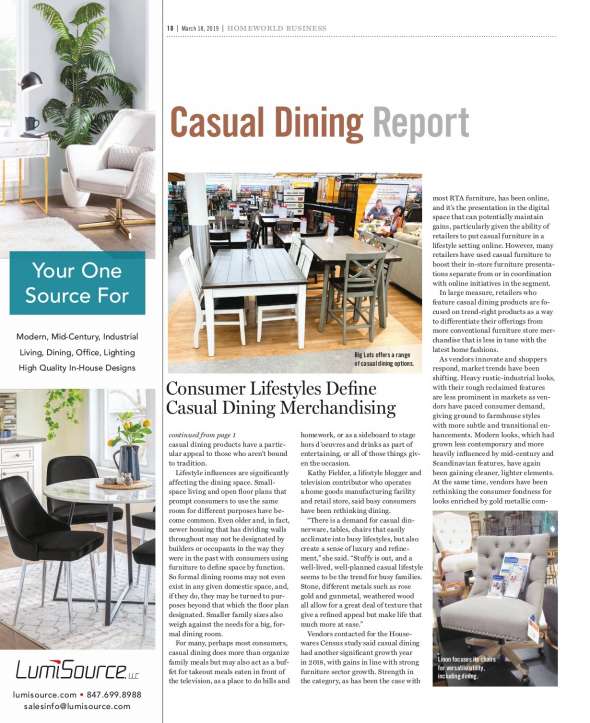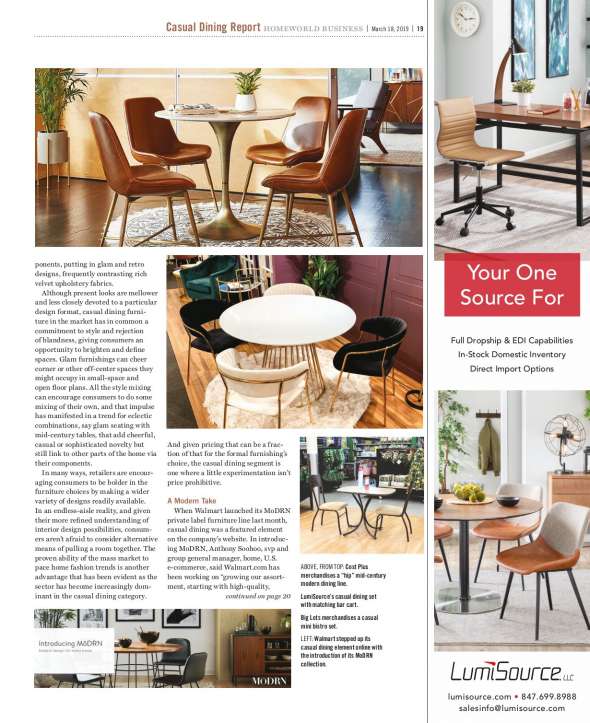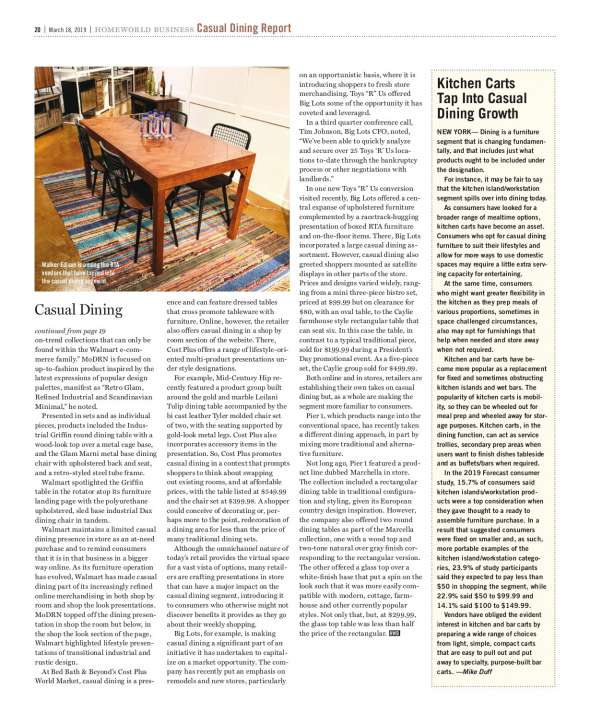NEW YORK— The stay at home consumer is changing how meals are enjoyed in the domestic space, and that has made casual dining an attractive alternative to more traditional food-related furnishings.
Many retailers are merchandising casual dining more conspicuously, which is giving it a more prominent position in the market as a category, or at least a defined subcategory. Formal dining furniture remains popular with many consumers, but casual dining products have a particular appeal to those who aren’t bound to tradition.
Lifestyle influences are significantly affecting the dining space. Small-space living and open floor plans that prompt consumers to use the same room for
different purposes have become common. Even older and, in fact, newer housing that has dividing walls throughout may not be designated by builders or occupants in the way they were in the past with consumers using furniture to define space by function. So formal dining rooms may not even exist in any given domestic space, and, if they do, they may be turned to purposes beyond that which the floor plan designated. Smaller family sizes also weigh against the needs for a big, formal dining room.
For many, perhaps most consumers, casual dining does more than organize family meals but may also act as a buffet for takeout meals eaten in front of the television, as a place to do bills and homework, or as a sideboard to stage hors d’oeuvres and drinks as part of entertaining, or all of those things given the occasion.
Kathy Fielder, a lifestyle blogger and television contributor who operates a home goods manufacturing facility and retail store, said busy consumers have been rethinking dining.
“There is a demand for casual dinnerware, tables, chairs that easily acclimate into busy lifestyles, but also create a sense of luxury and refinement,” she said. “Stuffy is out, and a well-lived, well-planned casual lifestyle seems to be the trend for busy families. Stone, different metals such as rose gold and gunmetal, weathered wood all allow for a great deal of texture that give a refined appeal but make life that much more at ease.”
Vendors contacted for the Housewares Census study said casual dining had another significant growth year in 2018, with gains in line with strong furniture sector growth. Strength in the category, as has been the case with most RTA furniture, has been online, and it’s the presentation in the digital space that can potentially maintain gains, particularly given the ability of retailers to put casual furniture in a lifestyle setting online. However, many retailers have used casual furniture to boost their in-store furniture presentations separate from or in coordination with online initiatives in the segment.
In large measure, retailers who feature casual dining products are focused on trend-right products as a way to differentiate their offerings from more conventional furniture store merchandise that is less in tune with the latest home fashions.
As vendors innovate and shoppers respond, market trends have been shifting. Heavy rustic-industrial looks, with their rough reclaimed features are less prominent in markets as vendors have paced consumer demand, giving ground to farmhouse styles with more subtle and transitional enhancements. Modern looks, which had grown less contemporary and more heavily influenced by mid-century and Scandinavian features, have again been gaining cleaner, lighter elements. At the same time, vendors have been rethinking the consumer fondness for looks enriched by gold metallic components, putting in glam and retro designs, frequently contrasting rich velvet upholstery fabrics.
Although present looks are mellower and less closely devoted to a particular design format, casual dining furniture in the market has in common a commitment to style and rejection of blandness, giving consumers an opportunity to brighten and define spaces. Glam furnishings can cheer corner or other off-center spaces they might occupy in small-space and open floor plans. All the style mixing can encourage consumers to do some mixing of their own, and that impulse has manifested in a trend for eclectic combinations, say glam seating with mid-century tables, that add cheerful, casual or sophisticated novelty but still link to other parts of the home via their components.
In many ways, retailers are encouraging consumers to be bolder in the furniture choices by making a wider variety of designs readily available. In an endless-aisle reality, and given their more refined understanding of interior design possibilities, consumers aren’t afraid to consider alternative means of pulling a room together. The proven ability of the mass market to pace home fashion trends is another advantage that has been evident as the sector has become increasingly dominant in the casual dining category. And given pricing that can be a fraction of that for the formal furnishing’s choice, the casual dining segment is one where a little experimentation isn’t price prohibitive.
A Modern Take
When Walmart launched its MoDRN private label furniture line last month, casual dining was a featured element on the company’s website. In introducing MoDRN, Anthony Soohoo, svp and group general manager, home, U.S. e-commerce, said Walmart.com has been working on “growing our assortment, starting with high-quality, on-trend collections that can only be found within the Walmart e-commerce family.” MoDRN is focused on up-to-fashion product inspired by the latest expressions of popular design palettes, manifest as “Retro Glam, Refined Industrial and Scandinavian Minimal,” he noted.
Presented in sets and as individual pieces, products included the Industrial Griffin round dining table with a wood-look top over a metal cage base, and the Glam Marni metal base dining chair with upholstered back and seat, and a retro-styled steel tube frame.
Walmart spotlighted the Griffin table in the rotator atop its furniture landing page with the polyurethane upholstered, sled base industrial Dax dining chair in tandem.
Walmart maintains a limited casual dining presence in store as an at-need purchase and to remind consumers that it is in that business in a bigger way online. As its furniture operation has evolved, Walmart has made casual dining part of its increasingly refined online merchandising in both shop by room and shop the look presentations. MoDRN topped off the dining presentation in shop the room but below, in the shop the look section of the page, Walmart highlighted lifestyle presentations of transitional industrial and rustic design.
At Bed Bath & Beyond’s Cost Plus World Market, casual dining is a presence and can feature dressed tables that cross promote tableware with furniture. Online, however, the retailer also offers casual dining in a shop by room section of the website. There, Cost Plus offers a range of lifestyle-oriented multi-product presentations under style designations.
For example, Mid-Century Hip recently featured a product group built around the gold and marble Leilani Tulip dining table accompanied by the bi cast leather Tyler molded chair set of two, with the seating supported by gold-look metal legs. Cost Plus also incorporates accessory items in the presentation. So, Cost Plus promotes casual dining in a context that prompts shoppers to think about swapping out existing rooms, and at affordable prices, with the table listed at $549.99 and the chair set at $399.98. A shopper could conceive of decorating or, perhaps more to the point, redecoration of a dining area for less than the price of many traditional dining sets.
Although the omnichannel nature of today’s retail provides the virtual space for a vast vista of options, many retailers are crafting presentations in store that can have a major impact on the casual dining segment, introducing it to consumers who otherwise might not discover benefits it provides as they go about their weekly shopping.
Big Lots, for example, is making casual dining a significant part of an initiative it has undertaken to capitalize on a market opportunity. The company has recently put an emphasis on remodels and new stores, particularly on an opportunistic basis, where it is introducing shoppers to fresh store merchandising. Toys “R” Us offered Big Lots some of the opportunity it has coveted and leveraged.
In a third quarter conference call, Tim Johnson, Big Lots CFO, noted, “We’ve been able to quickly analyze and secure over 25 Toys ‘R’ Us locations to-date through the bankruptcy process or other negotiations with landlords.”
In one new Toys “R” Us conversion visited recently, Big Lots offered a central expanse of upholstered furniture complemented by a racetrack-hugging presentation of boxed RTA furniture and on-the-floor items. There, Big Lots incorporated a large casual dining assortment. However, casual dining also greeted shoppers mounted as satellite displays in other parts of the store. Prices and designs varied widely, ranging from a mini three-piece bistro set, priced at $99.99 but on clearance for $80, with an oval table, to the Caylie farmhouse style rectangular table that can seat six. In this case the table, in contrast to a typical traditional piece, sold for $199.99 during a President’s Day promotional event. As a five-piece set, the Caylie group sold for $499.99.
Both online and in stores, retailers are establishing their own takes on casual dining but, as a whole are making the segment more familiar to consumers.
Pier 1, which products range into the conventional space, has recently taken a different dining approach, in part by mixing more traditional and alternative furniture.
Not long ago, Pier 1 featured a product line dubbed Marchella in store. The collection included a rectangular dining table in traditional configuration and styling, given its European country design inspiration. However, the company also offered two round dining tables as part of the Marcella collection, one with a wood top and two-tone natural over gray finish corresponding to the rectangular version. The other offered a glass top over a white-finish base that put a spin on the look such that it was more easily compatible with modern, cottage, farmhouse and other currently popular styles. Not only that, but, at $299.99, the glass top table was less than half the price of the rectangular.




